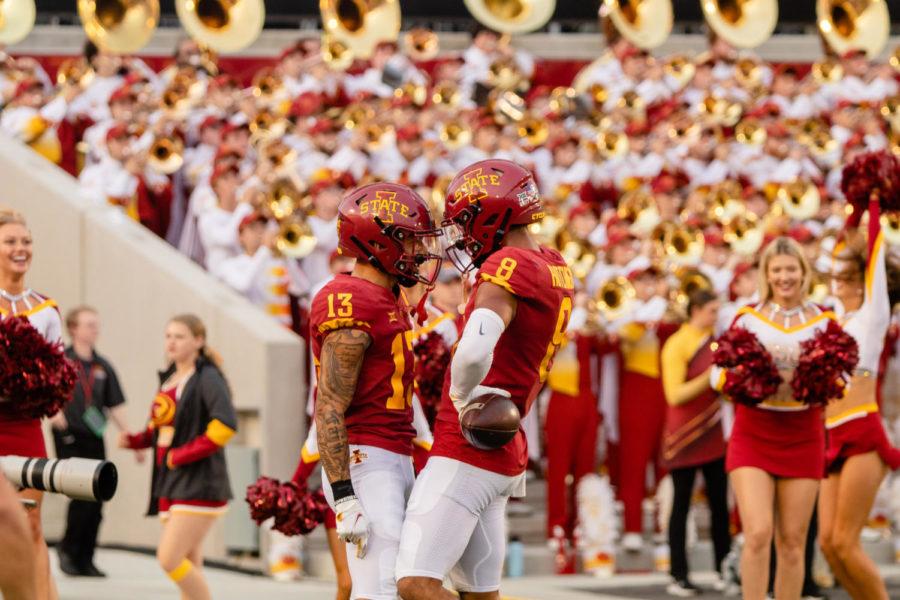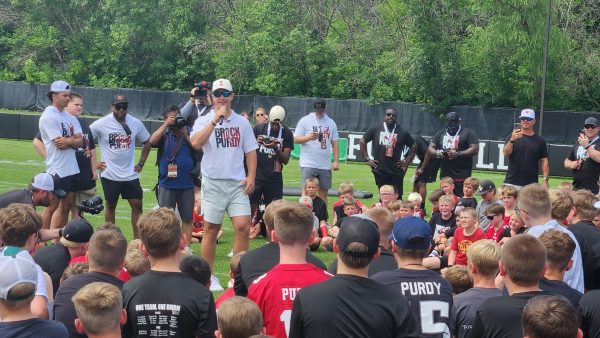Stuve: My checklist for Iowa State after its bye week
October 11, 2021
Iowa State (3-2, 1-1 Big 12) is coming off its bye week and is in the middle of the race for one of the two spots in the 2021 Big 12 Championship.
With the bye week now in the rearview mirror, I’m going to highlight some things that I think may be most interesting to follow, as well as some questions I have as Iowa State gears up for the home stretch.
Will there be a consistent third receiver threat?
So far this season, wide receiver Xavier Hutchinson and tight end Charlie Kolar have been the go-to guys for starting quarterback Brock Purdy.
Hutchinson and Kolar have caught 49 of the 109 completed passes and running back Breece Hall has accounted for 16 of the completed passes as well.
Those two, with Hall, are the top three in receiving yards for Iowa State as Hall has 117 yards, Kolar has 238 and Hutchinson has 383.
At times this season, there has been another wide receiver or tight end that has made big plays or been effective but there could be more consistency in that regard.
Iowa State has some good plays and production from a third receiver (or a second tight end), but never consistently from one player.
While I think it’s a good thing that different players have been making plays for Iowa State and the talent is definitely there, I think that having a consistent third option as a receiver or tight is a vital for an offense like Iowa State’s.
Tight end Chase Allen, who has been described as an “A” player by head coach Matt Campbell, is tied for fourth on the team in receptions with nine and is fourth in receiving yards with 112. But seven of those receptions and 98 yards came in the Baylor game, meaning that Allen has two receptions for 14 yards in the other four games, including two games with zero catches.
Tied with Allen for fourth in receptions is wide receiver Tarique Milton, who has nine receptions and one touchdown. Most of that production came in the first two games, as Milton has been held to four receptions for 31 yards in the last three games.
Fourth on the list in receiving yards is Joe Scates, who has six receptions for 107 yards and a touchdown, which came on a 44 yard pass against Kansas.
Whether it’s Allen, Milton, or Scates, having one or more players who can consistently have 4+ reception games will make this offense more lethal.
Having one of these players became a more consistent receiving threat could do wonders for Iowa State’s offense. Not only would it require opposing secondaries to devote more attention to them and less to Hutchinson and Kolar, but it could open up more opportunities in the running game as well.
Improvement in punting?
The Cyclones have struggled a bit in the punting game this season. Currently, Iowa State is tied for last in the Big 12 in yards per punt at 39.8 and rank 106th nationally. And that doesn’t even include net yardage.
Iowa State’s net average on punts is 32.2, which is dead last in the Big 12 and is 124th in the country.
Now this number may be a bit skewed because it takes into account the return or a touchback, but regardless, that number is not good.
Punt coverage has been a problem at times this season, as on the eight punt returns Iowa State’s opponents have had this season, their average is 16.62 yards per return.
Heading into Saturday’s game on the road against Kansas State, there appears to be a bit of a punter battle still going on.
Corey Dunn has had the majority of the punts and is listed as the starter, but Cameron Shook was the punter Iowa State trotted out against Kansas on three occasions.
It is often said that special teams can decide games. It can flip field position, it can create momentum, but also it could be disastrous as well.
This is especially true I think in conference games against tough opponents, like Iowa State has up ahead.
I think that the losses to Iowa and Baylor are perfect examples of how special teams can affect games. Both teams had at three punts of 50 yards or more and at least three punts that pinned Iowa State inside its own 20 yard line.
While there are different factors that go into each punt, I think that Iowa State’s punting has left a little more to be desired.
Can Iowa State get something going in the return game?
While big punts can certainly affect moment and affect field position, punt and kick returns can break a game open and ultimately be the difference maker in some games.
I think that the results of Iowa State’s games and the statistics, show that the big plays in special teams have been made by Iowa State’s opponent, and not them.
Heading into the sixth game of the season, Iowa State sits in the bottom half of the Big 12 in both kick returning and punt returning.
Iowa State ranks sixth in the Big 12 in both punt returning and kick returning, averaging just 5.8 yards on punt returns and 23.5 yards on kick returns.
Jaylin Noel has had the kick return duties this season and is averaging 5.22 yards per return on nine attempts. His longest return of the season is nine yards.
On kick-offs, Iowa State has returned just four kickoffs. Now a lot of this is due to touchbacks or the decision to not bring the ball out.
In the punt return game, Iowa State is fielding an average of two punts a game, which obviously is altered by maybe a bad punt by the other team or a punt that leaves the returner with no choice but to fair catch it. But when Iowa State does have the return opportunities, the yardage picked up has been small.
While there may not be a ton of opportunities to make these kinds of plays, they can decide a game from time to time.
That’s been the case in recent history for Iowa State, as Baylor had a kick return for a touchdown in its 31-29 win over Iowa State.
If you go back to last season, Kene Nwangwu had a big return in the Oklahoma game that set Iowa State up for a decisive touchdown in a close win.
While the majority of the time a punt or a kickoff will not be returned for a touchdown, the return can help give the offense a kickstart and shift momentum, but so far this season Iowa State has not been able to create that momentum in the return game.
Can Iowa State get more pressure the quarterback in the first half?
There’s not a lot of critiques that can be given to the Iowa State defense in my opinion, but if there is one, it’s that Iowa State has not recorded a sack in the first half of a game in the last two outings.
Iowa State’s sack-attack is led by defensive lineman Enyi Uwazurike and Will McDonald, who led the nation in sacks a season ago.
These two have a combined 6.5 sacks (3 by Uwazurike and 3.5 by McDonald) this season.
But without those two the rest of the Iowa State defense has gone dry in the sack department, specifically in the first half.
The Cyclones have not recorded a first half sack since the UNLV game on Sept. 18.
Going sack-less in the first half of the Baylor game on Sept. 25 may have been one of the reasons why the defense surrendered 21 points in the first half, although the Cyclones defense would recover and limit Baylor’s offense to just a field goal in the second half.
Another interesting note is that the Cyclones went without a sack against the Kansas Jayhawks on Oct. 2. Now obviously the Cyclones defense still played great in spite of going sack-less, but getting pressure on the quarterback should be vital to the team’s success as the Big 12 schedule rolls on.
Currently, the Cyclones are in the bottom half of the conference in total sacks with 11, although they have played one less game than five of the other nine teams in the conference. Even so, they are averaging just 2.2 sacks per game which is sixth in the Big 12.
I think there are a couple things that factor in when you think about how many times a team gets to the opposing quarterback.
For one, the other team could be a run-heavy offense that doesn’t drop back to throw that often.
Secondly, the defense may only be rushing three or four on a play.
Lastly, it depends on how they are being blocked by the opposing offensive line. Sometimes there’s double teams or sometimes, a player is being held like no tomorrow, like McDonald was against UNLV.
Iowa State’s front six is dangerous and talented and that is shown in the ability to stop the run and the numbers reflect that I think.
Iowa State allows the ninth-fewest rushing yards at 90 per game. But in terms of getting a consistent pressure on the quarterback, there could be a little room for improvement.

















